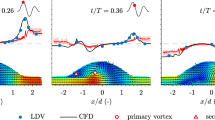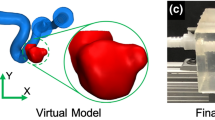Abstract
The effect of inflow waveform on the hemodynamics of a real-size idealized sidewall intracranial aneurysm (IA) model was investigated using particle imaging velocimetry (PIV). For this purpose, we implemented an error analysis based on several PIV measurements with different time lags to ensure high precision of velocity fields measured in both the IA and the parent artery. The relative error measured in the main part of the circulating volume was <1 % despite the three orders of magnitude difference of parent artery and IA dome velocities. Moreover, important features involved in IA evolution were potentially emphasized from the qualitative and quantitative flow pattern comparison resulting from steady and unsteady inflows. In particular, the flow transfer in IA and the vortical structure were significantly modified when increasing the number of harmonics for a typical physiological flow, in comparison with quasi-steady conditions.









Similar content being viewed by others
Notes
In this adaptive correlation algorithm, the interrogation windows are refined twice from \(128 \times 128\) pixels to \(32 \times 32\) pixels i.e \(\approx 1.3\times 1.3\)mm to \(\approx 0.33 \times 0.33\,\hbox {mm}\).
Adaptive PIV correlation algorithm (Dynamic Studio, Dantec Dynamics) was used to compute the velocity fields in IA model. This algorithm optimizes the size of the interrogation windows (\(32 \times 32\) pixels to \(64 \times 64\) pixels i.e. \(\approx 0.28 \times 0.28\,\hbox {mm}\) to \(\approx 0.55 \times 0.55\,\hbox {mm}\)) according to the local density of seeding particles and the velocity gradient.
Or unsteadiness when considering a steady inflow.
For a 2D velocity field \(\sigma _{v}\approx [(\sigma _{v_x}v_x)^2+(\sigma _{v_y}v_y)^2]^{1/2}/v\).
\({\mathfrak {I}}\) is the imaginary part of component in parenthesis.
Note that this effect becomes negligible in larger r = 3 mm tubes (not shown here).
The corresponding Reynolds numbers are \(Re = 68, 136, 273, 545, 1,091\).
The quasi-steady approximation consists in approximating the time dependence of pulsatile flow at time t by the steady velocity field with inlet flows \(q(t)\). The time dependence of each component, \(v_{x,y}\), of the quasi-steady velocity field was interpolated locally using a linear interpolation between the five steady flow measurements at \(q = 1, 2, 4, 8, 16\,\hbox {ml/s}\) shown in Fig. 4b.3–4 and Fig. 5.
We define the velocity exchange at the neck surface as \(v^{\mathrm{ex}}_{S_{\mathrm{N}}} = 1/|S_{\mathrm{N}}|\int _{S_{\mathrm{N}}}|\mathbf{v}\cdot \text {d}{\varvec{\sigma }}|\). This quantity measures the flow transfer between the parent artery and IA, normalized to neck area.
\(q_{\mathrm{max}}\) and \(q_{\mathrm{min}}\) are the maximum and minimum inflow rates during the cardiac cycle.
rect is the rectangular function.
Close to \(y_j\approx 0\) (in the center of the cylinder) the linear system becomes unstable. It is therefore recommended to use a polynomial development of \(v_x(y_j)\) to solve Eq. (10).
References
Cebral JR, Mut F, Weir J, Putman C (2011) Quantitative characterization of the hemodynamic environment in ruptured and unruptured brain aneurysms. AJNR Am J Neuroradiol 32(1):145–151
de Rooij NK, Linn FHH, van der Plas JA, Algra A, Rinkel GJE (2007) Incidence of subarachnoid haemorrhage: a systematic review with emphasis on region, age, gender and time trends. J Neurol Neurosurg Psychiatr 78(12):1365–1372
Ford MD, Lee SW, Lownie SP, Holdsworth DW, Steinman DA (2008a) On the effect of parent-aneurysm angle on flow patterns in basilar tip aneurysms: Towards a surrogate geometric marker of intra-aneurismal hemodynamics. J Biomech 41(2):241–248
Ford MD, Nikolov HN, Milner JS, Lownie SP, DeMont EM, Kalata W, Loth F, Holdsworth DW, Steinman DA (2008b) Piv-measured versus cfd-predicted flow dynamics in anatomically realistic cerebral aneurysm models. J Biomech Eng-T ASME 130(2):021015
Gosling RG, King DH (1974) Arterial assessment by doppler-shift ultrasound. Proc R Soc Med 67(6 Pt 1):447–449
Hain R, Kaehler CJ (2007) Fundamentals of multiframe particle image velocimetry (piv). Exp Fluids 42(4):575–587
He X, Ku DN (1994) Unsteady entrance flow development in a straight tube. J Biomech Eng-T ASME 116(3):355–360
Hoi Y, Woodward SH, Kim M, Taulbee DB, Meng H (2006) Validation of cfd simulations of cerebral aneurysms with implication of geometric variations. J Biomech Eng-T ASME 128(6):844–851
Le TB, Borazjani I, Sotiropoulos F (2010) Pulsatile flow effects on the hemodynamics of intracranial aneurysms. J Biomech Eng-T ASME 132(11):111009
Le TB, Troolin DR, Amatya D, Longmire EK, Sotiropoulos F (2013) Vortex phenomena in sidewall aneurysm hemodynamics: experiment and numerical simulation. Ann Biomed Eng 41(10):2157–2170
Liou T, Liao C (1997) Flowfields in lateral aneurysm models arising from parent vessels with different curvatures using ptv. Exp Fluids 23(4):288–298
Liou TM, Yi-Chen L, Juan WC (2007) Numerical and experimental studies on pulsatile flow in aneurysms arising laterally from a curved parent vessel at various angles. J Biomech 40(6):1268–1275
Liu W, Ribeiro E (2010) Scale and rotation invariant detection of singular patterns in vector flow fields. Springer, Berlin
Lu G, Huang L, Zhang XL, Wang SZ, Hong Y, Hu Z, Geng DY (2011) Influence of hemodynamic factors on rupture of intracranial aneurysms: Patient-specific 3d mirror aneurysms model computational fluid dynamics simulation. AJNR Am J Neuroradiol 32(7):1255–1261
Marquering HA, van Ooij P, Streekstra GJ, Schneiders JJ, Majoie CB, vanBavel E, Nederveen AJ (2011) Multiscale flow patterns within an intracranial aneurysm phantom. IEEE T Bio-Med Eng 58(12, 2):3447–3450
Meyer F (1994) Topographic distance and watershed lines. Signal Processing 38(1):113–125
Morino T, Tanoue T, Tateshima S, Vinuela F, Tanishita K (2010) Intra-aneurysmal blood flow based on patient-specific ct angiogram. Exp Fluids 49(2):485–496
Morita A, Kirino T, Hashi K, Aoki N, Fukuhara S, Hashimoto N, Nakayama T, Sakai M, Teramoto A, Tominari S, Yoshimoto T (2012) The natural course of unruptured cerebral aneurysms in a japanese cohort. N Engl J Med 366(26):2474–2482
Mulder G, Bogaerds ACB, Rongen P, van de Vosse FN (2009) On automated analysis of flow patterns in cerebral aneurysms based on vortex identification. J Eng Math 64(4):391–401
Pereira F, Ciarravano A, Romano G, Di Felice F (2004) Adaptive multi-frame piv. In: Adaptive multi-frame PIV. In: 12th international symposium on applications of laser techniques to fluid mechanics, Lisbon, Portugal, 12–15 July 2004
Pereira VM, Bonnefous O, Ouared R, Brina O, Stawiaski J, Aerts H, Ruijters D, Narata AP, Bijlenga P, Schaller K, Lovblad KO (2013) A dsa-based method using contrast-motion estimation for the assessment of the intra-aneurysmal flow changes induced by flow-diverter stents. AJNR Am J Neuroradiol 34(4):808–815
Pereira VM, Brina O, Bijlanga P, Bouillot P, Narata AP, Schaller K, Lovblad KO, Ouared R (2014) Wall shear stress distribution of small aneurysms prone to rupture: a case control study. Stroke 45(1):261–264
Pozrikidis C (1994) Shear flow over a plane wall with an axisymmetric cavity or a circular orifice of finite thickness. Phys Fluids 6(1):68–79
Raffel M, Willert C, Wereley S, Kompenhans J (2007) Particle image velocimetry. Springer, Heidelberg
Raschi M, Mut F, Byrne G, Putman CM, Tateshima S, Vinuela F, Tanoue T, Tanishita K, Cebral JR (2012) Cfd and piv analysis of hemodynamics in a growing intracranial aneurysm. Int J Numer Method Biomed Eng 28(2):214–228
Reymond P, Merenda F, Perren F, Ruefenacht D, Stergiopulos N (2009) Validation of a one-dimensional model of the systemic arterial tree. Am J Physiol Heart Circ Physiol 297(1):H208–H222
Tanoue T, Tateshima S, Villablanca JP, Vinuela F, Tanishita K (2011) Wall shear stress distribution inside growing cerebral aneurysm. Am J Neuradiol 32(9):1732–1737
Tateshima S, Vinuela F, Villablanca J, Murayama Y, Morino T, Nomura K, Tanishita K (2003) Three-dimensional blood flow analysis in a wide-necked internal carotid artery-ophthalmic artery aneurysm. J Neurosurg 99(3):526–533
Tateshima S, Tanishita K, Omura H, Villablanca JP, Vinuela F (2007) Intra-aneurysmal hemodynamics during the growth of an unruptured aneurysm: In vitro study using longitudinal ct angiogram database. Am J Neuroradiol 28(4):622–627
Tateshima S, Tanishita K, Omura H, Sayre J, Villablanca JP, Martin N, Vinuela F (2008) Intra-aneurysmal hemodynamics in a large middle cerebral artery aneurysm with wall atherosclerosis. Surg Neurol 70(5):454–462
Ugron A, Farinas MI, Kiss L, Paal G (2012) Unsteady velocity measurements in a realistic intracranial aneurysm model. Exp Fluids 52(1):37–52
Vlak MHM, Algra A, Brandenburg R, Rinkel GJE (2011) Prevalence of unruptured intracranial aneurysms, with emphasis on sex, age, comorbidity, country, and time period: a systematic review and meta-analysis. Lancet Neurol 10(7):626–636
van de Vosse F, van Dongen M (1998) Cardiovascular fluid mechanics. Eindhoven University of Technology. http://www.mate.tue.nl/people/vosse/docs/cardio.pdf
Xiang J, Tutino V, Snyder K, Meng H (2014) Cfd: Computational fluid dynamics or confounding factor dissemination? the role of hemodynamics in intracranial aneurysm rupture risk assessment. Am J Neuradiol [Epub ahead of print]
Yamaguchi R, Ujiie H, Haida S, Nakazawa N, Hori T (2008) Velocity profile and wall shear stress of saccular aneurysms at the anterior communicating artery. Heart Vessels 23(1):60–66
Yu S, Zhao J (1999) Steady and pulsating flow characteristics in straight tubes with and without a lateral circular protrusion. Exp Fluids 26(6):505–512
Zhang Z (2010) LDA application methods. Springer, Heidelberg
Acknowledgments
We would like to thank the technical support of the LMH for the realization of the experimental setup. P. Bouillot thanks the Vasco Sanz Foundation for its support.
Author information
Authors and Affiliations
Corresponding author
Electronic supplementary material
Below is the link to the electronic supplementary material.
Appendix: Laser thickness correction
Appendix: Laser thickness correction
Due to its finite thickness, h, the laser sheet enlighten particles located in different out-of-planes distances from the center of the measurement plane. The computation of the velocity field from the recorded pictures by means of cross-correlations is therefore influenced by all the velocities in the illuminated sheet. Assuming a cylindrical symmetry of the actual velocity profile \(v_x(y,z) = v_x(s)\) with \(s = \sqrt{y^2+z^2}\), the measured velocity profile in the symmetry plane at the \(j^{\text {th}}\) radial measured location, \(v^{\text {mes}}_z(y_j)\), can be written as a weighted sum
w(z) weights the effect of each illuminated particle on the computed velocity field according to their out-of-plane distance, z. The second equality comes from a Taylor expansion of \(v_x\) at fixed \(y = y_j\) and for \(z = 0\). \(w_n = \int z^nw(z)\text {d}z\) is the nth momentum of w(z).
For a uniform weighted functionFootnote 11 \(w(z) = h^{-1}\text {rect}\left( z/h\right)\) (i.e. assuming that all the enlighten particles have the same effect on the computed velocity fields) and keeping only the first \(n\leqslant 2\) components of the Taylor expansion in (10), we can write
Using the finite difference approximation \(\text {d} v_x /\text {d} s|_{s = y_j}\approx [v_x(y_{j+1})-v_x(y_{j-1})] /(y_{j+1}-y_{j-1})\), Eq. (11) becomes a linear system which can be solved forFootnote 12 \(v_x(y_j)\). The results shown in Figs. 3 and 8a assume a measured laser thickness \(h = 1\,\hbox {mm}\).
Rights and permissions
About this article
Cite this article
Bouillot, P., Brina, O., Ouared, R. et al. Multi-time-lag PIV analysis of steady and pulsatile flows in a sidewall aneurysm. Exp Fluids 55, 1746 (2014). https://doi.org/10.1007/s00348-014-1746-0
Received:
Revised:
Accepted:
Published:
DOI: https://doi.org/10.1007/s00348-014-1746-0




